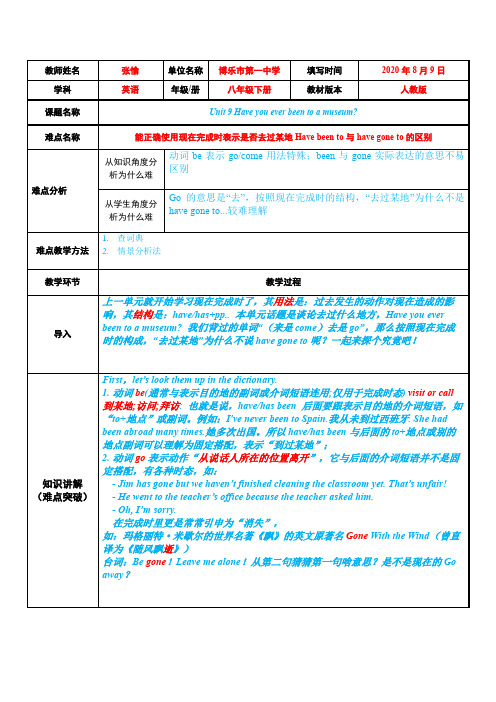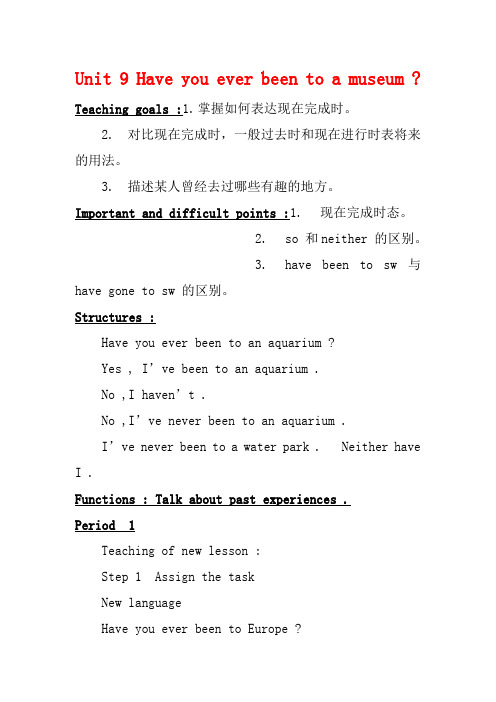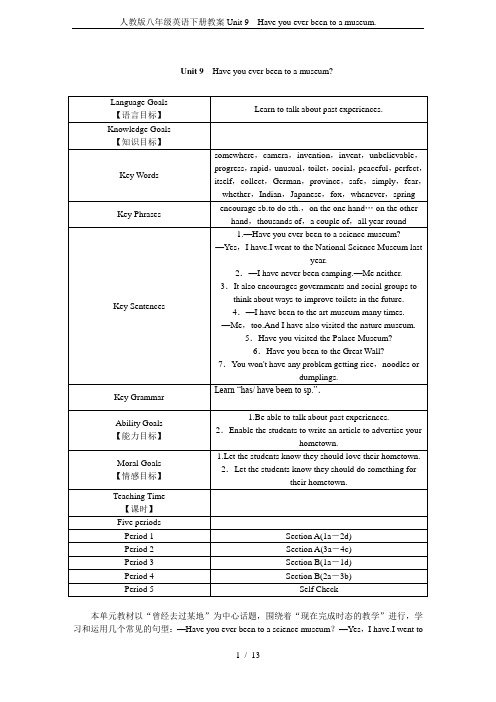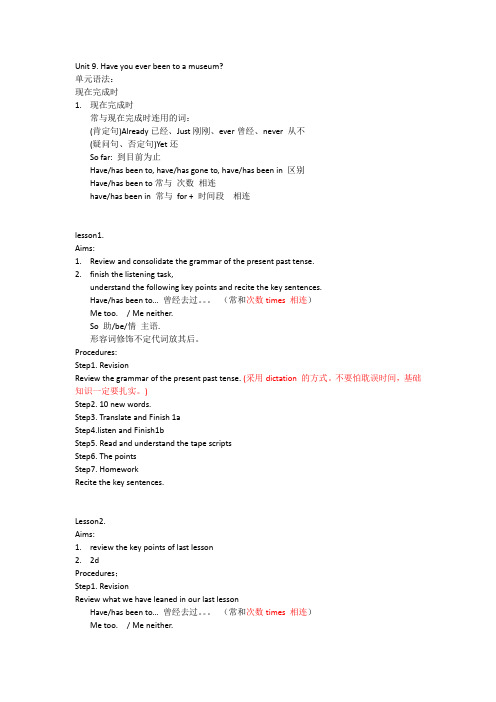八年级英语下册Unit9Haveyoueverbeentoamuseum教案(新版)人教新目标版
- 格式:doc
- 大小:31.50 KB
- 文档页数:2

人教版英语八年级下册Unit 9《Have you ever been to a museum》教学设计一. 教材分析人教版英语八年级下册Unit 9《Have you ever been to a museum》主要讨论了人们参观博物馆、公园等地方的经历。
通过本节课的学习,学生能够掌握一般过去时的疑问句和回答,以及描述过去发生的事情。
教材中包含了丰富的图片、对话和练习,有助于激发学生的学习兴趣,提高他们的语言运用能力。
二. 学情分析八年级的学生已经掌握了一般现在时和一般过去时的基本用法,具备一定的听说读写能力。
但部分学生在实际运用中仍存在困难,如疑问句的构成、时态的运用等。
此外,学生的英语学习兴趣和动机有待提高。
三. 教学目标1.知识目标:–学会一般过去时的疑问句和回答;–掌握描述过去发生事情的句型;–了解博物馆、公园等地方的相关词汇。
2.能力目标:–能够用英语询问并描述别人过去的经历;–提高学生的听说读写能力。
3.情感目标:–培养学生对英语学习的兴趣;–培养学生热爱博物馆、公园等公共场所的意识。
四. 教学重难点•一般过去时的疑问句和回答;•描述过去发生事情的句型。
•疑问句的构成和时态的运用;•动词过去式的拼写规则。
五. 教学方法1.情境教学法:通过创设情境,让学生在实际语境中感受和运用英语;2.交际法:鼓励学生参与课堂互动,提高他们的口语表达能力;3.任务型教学法:通过完成任务,培养学生运用英语解决问题的能力;4.游戏教学法:通过趣味游戏,激发学生的学习兴趣。
六. 教学准备1.教学课件:制作课件,包含图片、动画、练习等;2.教学道具:准备相关场所的图片、卡片等;3.音频材料:下载相关听力材料,如录音、歌曲等;4.课堂练习:准备相应的练习题,巩固所学内容。
七. 教学过程1.导入(5分钟)–教师展示一张博物馆的图片,询问学生是否去过博物馆,引导学生谈论自己的经历。
2.呈现(10分钟)–教师展示课件,呈现本节课的主要内容,包括博物馆、公园等地方的词汇以及一般过去时的疑问句和回答。


Unit 9 Have you ever been to a museum ? Teaching goals :1. 掌握如何表达现在完成时。
2. 对比现在完成时,一般过去时和现在进行时表将来的用法。
3. 描述某人曾经去过哪些有趣的地方。
Important and difficult points :1. 现在完成时态。
2. so 和neither 的区别。
3. have been to sw 与have gone to sw 的区别。
Structures :Have you ever been to an aquarium ?Yes , I’ve been to an aquarium .No ,I haven’t .No ,I’ve never been to an aquarium .I’ve never been to a water park . Neither have I .Functions : Talk about past experiences .Period 1Teaching of new lesson :Step 1 Assign the taskNew languageHave you ever been to Europe ?Yes ,I have . / No , I’ve never been to Europe .In this unit ,students learn to talk about past experiences in the other way .Step 2 Warm up Section A (1a-1c)SB Page 68 , 1a .1. Read each of the words and phras es at the top of the page to the class .2. Read the instructions .3. Do a quick check to see where Ss would like most to visit .SB Page 68 , 1b .1. Read the instructions .2. Point out the sample answer .3. Play the recording .Ask Ss to check off their answers .SB Page 68 , 1c .1. Read the instructions for the activity .2. Point to the example in the sample dialogue .Ask two students to read the dialogue to the class .3. Then have Ss work in pairs .4. Check the answers by calling on several different pairs of students to say their conversations to theclass .Step 3 Pre-taskSB Page 69 , 2a .1. Read the instructions .2. Point to the map ,play the recording and ask Ss to circle places on the map .3. Correct the answers .SB Page 69 , 2b .1. Read the instructions .Point out the sample answer .2. Po int out the statements about the three conversations .3. Play the recording again .Ask Ss to circle the word true or false after each statement .4. Correct the answers .SB Page 69 , 2c .1. Point to the map and tell Ss they can talk about any of the places on the map .2. Ask Ss to work in pairs .3. Ask several pairs of students to say their conversations to the class .Step 4 Grammar FocusReview the grammar box .Ask students to say the statements and responses .Exercise designing for Period 1 :词组翻译1. 太空博物馆2. 娱乐公园3. 水上公园4. 乘地铁在5. 去年6. 明年Period 2Teaching of new lessonsStep 1 Pre-taskSB Page 70 , 3a .1. Read the instructions .2. Then read the story to the class .After you finish ,ask if Ss have any questions about words and phrases in the article .3. Ask Ss to read the story again .Circle all the interesting things .4. Discuss the students’ answers .SB Page 70 , 3b .1. Read the instructions .2. Ask a pair of students to read the example in sample dialogue to the class .3. Then Ss work in pairs .4. Ask one or two pairs to say their conversationsto the class .Step 2 While-task1. Read the instructions .2. Ask two students to read the dialogue .3. Ask another pair of st udents to talk about something else they have .They should use the phrase : Have you ever … ?4. Ask Ss to complete the work in pairs .5. Ask a few students to share their list .You can ask for details and explanations of their answers .Exercise designing for Period 2 :词组翻译1. 从没去过迪斯尼乐园2. 玩得愉快3. 结束4. 主题公园5. 当然6. 一直7. 许多著名的人物8. 听说9. 行驶不同的路线 10. 在同一个地方Period 3Teaching of new lessonStep 1 Assign taskSB Page 71 , 1a .1. Read the instructions.2. Read each sentence to the class .3. Read the instruction again and say , Put 1afterthe most important reason that you learn English ,put 2 after the second most important reason and continue the same way .4. Do a quick check to see which reasons Ss think are most important .SB Page 71 , 1b .1. Point to the example in the sample dialogue .Ask two students to read it to the class .2. Ss work in groups .3. Ask several groups to say their conversations .SB Page 71 , 2a .1. Read the instructions and point out the sample answer .2. Play the recor ding .Ask Ss to circle their answers .3. Check the answers .SB page 71 , 2b .1. Read the instru ctions and point out the questionnaire .Ask a student to read the headings at the left .2. Play the recording .Ask Ss to fill in the answers .3. Check the answers. Ask Ss to write the answers on the board .SB Page 71 , 2c .1. Point to the example in the sample dialogue .Ask two students to read it to the class .2. Ask Ss to work in small groups .3. Ask several pairs to say their conversations to the class .Step 2 While-taskSB Page 72 , 3a .1. Ask different students to read each of the paragraphs to the class .Answer any questions students may have .2. Then say, Now read the paragraphs again and answer the questions .Correct the answers .SB Page 72 , 3b .1. Ask Ss to review the information in activity 3a .2. Ss write articles about themselves .As they work , move around the room offering language support as needed .SB Page 72 , Part 4 .1. Read the instructions to the class .2. Point out the example in the speech bubbles and have two students read it to the class .3. Discuss the answers with the class .Period 4Teaching of new lessonStep 1 Self CheckSB Page 73 , Part 1 .1. Ask Ss to fill in the blanks on their own .2. Check the answers .3. Ask Ss to make their own sentences with the words .4. Write a number of students’ answers for each word on the boardSB Page 73 , Part 2 .1. Read the instructions with the students .2. Ask Ss to complete the task by interviewing other students .3. Ask Ss to share their results with the class .SB Page 73 , Part 3 .1. Read the instructions and sample answer with the students .2. Ask Ss to complete the task .3. Ask Ss to share their short report with the class .Make sure Ss include details .Step 2 While-readingHave you ever been to Singapore ?SB Page 74 , Section 1 .1. Ask Ss if they have ever thought about traveling to a favorite foreign destination .Elicit ideas as a class .2. Ask the groups to choose one of the capital cities in the box and write four things the group knows about it .3. Discuss answer as a class .SB Page 74 , Section 2 .Ask Ss to read slowly and thoughtfully .They should be aware of the words they are reading as they read .SB Page 75 , Section 3 .1. Ask Ss to scan the reading to find more words for the different categories .2. Ask the class for any unusual words that they have found .3. 3c. Tell Ss to first read the false informationgiven in the exercise .Then ask them to scan the readingto find the correct details to write a true sentence .4. Ss complete the task .5. Check the answers .Exercise designing for Period 4 :单项选择( )1. He to Canada ,so you can not see him recently .A. wentB. has beenC. has goneD. have been gone( )2. ¬¬— have you been there since you became a teacher—Twice .A. How oftenB. How soonC. How longD. Hoe many times( )3. London has ever hosted the modern Olympics Paris .A. So doesB. So hasC. Nor doesD. Neither has( )4. —I haven’t been to the space museum .— .A. So do IB. Me tooC. Me neitherD. So have I( )5. There ar e many stores you can buy souvenirs from my hometown .A . which B. where C. when D. there。

《Unit 9 Have you ever been to a museum? 》一、教学目标:1. 语言知识目标:掌握如何表达现在完成时,并能运用Have you ever been to an amusement park? Has he ever been to an amusement park? 的句式进行提问和应答。
2. 情感态度价值观目标:能用英语谈论过去的经历,谈论你曾经去过某地。
二、教学重点:(1)掌握本课的生词、短语和本课所出现的日常交际用语。
(2)掌握有关于“某人曾经去过某地”的交际用语:Have you ever been to an amusement park? Yes, I have. / No, I haven’t.Has he ever been to an amusement park? Yes, he has. / No, he hasn’t.三、教学难点:(1)熟练掌握和灵活运用现在完成时来描述某人曾经去过某地。
(2)能区别现在完成时和一般过去时在表达过去经历的不同。
四、教学方法:Task-based and communicative teaching methods.五、授课时间:6.6——6.8六、课时安排:4课时七、教学过程:Period 1Step 1 RevisionPlay the song “If you are happy, please clap your hands. (播放一首“幸福拍手歌”,让学生跟着一起唱,老师赶紧因势引导,问全班同学:)T: Do you know the name of this song?Ss: Yes, “If I am happy, I’ll clap my hands”.T:(教师重复并问学生)If you are happy, you’ll clap your hands. Are you happy today?Ss: Yes.T: If you are happy, please clap your hands.Ss: ××, ××, ××(学生们一起拍手)T:(问一名学生)If you are happy. What will you do?S1:If I am happy, I’ll go to the movies.T:(问另外一名学生)What about you?S2: I’ll go out for a visit but I don’t have enough money.T:(问另外一名学生)If you have a lot of money. What will you do?S3: If I am happy, I’ll buy a big house for my parents.T: Good boy. (Ask another student.) What about you?S4: I’ll give most of the money to the poor.T: How about you?Ss: I’ll travel around the world.T: Have you ever been to America?Ss: No.T: Now, we’ll learn Unit 9 Have you ever been to an amusement park?(播放歌曲,营造轻松愉快的学习氛围,并因势引导,采用师生之间的交流方式,自然导入“Have you ever been to an amusement park?”(“你曾经去过某地”这一话题)。

Unit 9Have you ever been to a museum?本单元教材以“曾经去过某地”为中心话题,围绕着“现在完成时态的教学”进行,学习和运用几个常见的句型:—Have you ever been to a science museum?—Yes,I have.I went tothe National Science Museum last year./—I have never been camping.—Me neither./It also encourages governments and social groups to think about ways to improve toilets in the future./—I have been to the art museum many times.—Me,too.And I have also visited the nature museum.等。
在学习过程中,学生在交流中,能促进师生之间的感情。
Section A主要学习几个常见的动词短语及句型Have you been to…?应掌握句型:—Have you ever been to a science museum?—Yes,I have.I went to the National Science Museum last year.等。
通过一篇短文介绍了学生们曾经去过的最有趣的博物馆,增加了学生的阅读量。
Section B安排了听、说、读、写的任务,通过短文“Singapore—A Place You Will Never Forget!”介绍了新加坡的一些情况。
教师在教学中应合理利用课本上的知识进行教学。
第一课时Section A(1a-2d)Teaching Key Points【教学重点】The vocabulary:amusement,somewhere,camera,invention,history/space/art museum,put up,have a good time,water/amusement parkTarget language:1.—Have you ever been to a science museum?—Yes,I have.I went to the National Science Museum last year.2.I have never been camping.3.It's a great way to spend a Saturday afternoon.Teaching Difficult Points【教学难点】Use the target language above to talk about past experiences.Teaching Aids【教学工具】an English book,a tape recorder and CAITeaching Steps【教学过程】★Step 1Preview and perception【预习感知】Ask the students to read the vocabulary and target language.Ⅰ.英译汉。

Unit 9. Have you ever been to a museum?单元语法:现在完成时1.现在完成时常与现在完成时连用的词:(肯定句)Already已经、Just刚刚、ever曾经、never 从不(疑问句、否定句)Yet还So far: 到目前为止Have/has been to, have/has gone to, have/has been in 区别Have/has been to常与次数相连have/has been in 常与for + 时间段相连lesson1.Aims:1.Review and consolidate the grammar of the present past tense.2.finish the listening task,understand the following key points and recite the key sentences.Have/has been to…曾经去过。
(常和次数times 相连)Me too. / Me neither.So 助/be/情主语.形容词修饰不定代词放其后。
Procedures:Step1. RevisionReview the grammar of the present past tense. (采用dictation 的方式。
不要怕耽误时间,基础知识一定要扎实。
)Step2. 10 new words.Step3. Translate and Finish 1aStep4.listen and Finish1bStep5. Read and understand the tape scriptsStep6. The pointsStep7. HomeworkRecite the key sentences.Lesson2.Aims:1.review the key points of last lesson2.2dProcedures;Step1. RevisionReview what we have leaned in our last lessonHave/has been to…曾经去过。
unit 9 have you ever been to amuseum教案1教案题目:Unit 9 "Have You Ever Been to a Museum?"教学目标:1. 学生能够掌握并正确使用本单元的词汇和短语。
2. 学生能够运用所学的句型和表达方式描述博物馆和展览。
3. 学生能够通过听说读写的综合训练,提高自己的综合语言运用能力。
教学重点:1. 本单元的词汇和短语的掌握和运用。
2. 对博物馆和展览进行描述的能力。
3. 学生的听说读写的综合训练。
教学难点:1. 对博物馆和展览进行描述的能力。
2. 学生的听说读写的综合训练。
教学准备:幻灯片、多媒体设备、展示物品、课件、练习册。
教学过程:Step 1: Warm-up (5 minutes)1. Greet the students and ask them if they have ever been to a museum.2. Show some pictures of famous museums and ask the students to name them。
3. Discuss with the students about their experiences in museums and what they have seen。
Step 2: Presentation (15 minutes)1. Present the new vocabulary and phrases related to museums and exhibitions using flashcards or pictures。
2. Introduce the target language structures through a short dialogue between a student and a teacher, using phrases like "Have you ever been to a museum?" and "What did you see there?"3. Model the pronunciation and intonation of the target language structures and have the students repeat after you。
Unit 9 Have you ever been to a museum?Section A 1 (1a-2d)教学目标1. Knowledge and Ability Objects(1) Key vocabulary: amusement; neither(2) Listening practice.(3) Target language:1.Lets' go somewhere different today.2.Have you ever been to…? Yes, I have./ No, I haven’t.3.How about/what about…?4.How are we going to get there?5.We can take the subway/…(4) To train students’ listening and speaking skills.2. Method Objects in Teaching(1) Scene teaching method.(2) Listening and speaking methods.(3) Pair work.3. Sensibility and ValueTo be interested in taking part in all kinds of activities in English class.教材分析1. Teaching Key Points1. Key vocabulary in this period.2. Target language in this period.2. Teaching DifficultyMake conversations freely using the target language.3. Teaching Aids1. A tape recorder.2. A computer for multimedia use.教学过程Teaching ProceduresStep 1 Greetings and RevisionGreet the class and check the homework.Step 2 Lead-in1.Guess the places of the pictures; they are the British Museum, space museum, historymuseum, water park, zoo, amusement park while lead in sentence p atterns:“ Have youever been to …?”2.SpeakingGet students to work in pairs to practice the conversation: “ Have you ever been to…”“Yes, I have”/ Not, I haven’t.Step 3 Pre-listening1. Section A 1aT: OK. Now open your books on Page 65. In Part 1a, 6 places are given. Please read the names of these places. (Teacher writes the names on the blackboard.) Which of theseplaces would you like to visit? Rank them from 1 to 5.S4:Amusement park ______, water park ______, zoo ______ aquarium ______ space museum ______.S 5: Space museum ______, aquarium ______, zoo ______, water park ______, amusement park ______S6: …2. Talk about the pictureStep 4 Listening1.Listen and choose the best answer. The first and the second question aim to listening to time,and the third one a ims to listen for the relationship. This activity trains students’ listening ability for listening for specific relationship.1)When did Sarah visit the National Science Museum?A. TodayB. Y esterdayC. Last year2)When did Claudia visit the nature museum?st yearB. last summerC. Last school trip3)What may the relationship be between the two speakers?A. FriendsB. Teacher and studentC. Mother and kid.Answer: CCA2.Listen again. Listen and check the boxes. Have these students ever been to these places?Science museum HistorymuseumArt museum Nature museum Space museumClaudiaSarah √Step 5 SpeakingAsk and answer in pairs:A: let’s go somewhere different today.B: OK. Where do you want to go?A: Have you ever been to the space museum?B: No, I haven’t. How about you?A: …Step 6 Listening 2a 2b1.Listen and circle the places that you hear.2.Listen again and circle T for true or F for false.Conversation 11. Tina went to the space museum last year. T/F2. John has never been to the space museum. T/F3. They are going to take the subway. T/FConversation 21. Linda has been to the amusement park. T/F2. Linda went to the amusement park yesterday. T/F3. Linda is going to the amusement park again by bike. T/FConversation 31. Frank had a great time at the water park. T/F2. Frank’s friend has never been to the water park. T/F3. Frank and his friend are going skating. T/FAnswer: TFT TFT FTT3.SpeakingLook at the map in 2a and make conversations about the places.A: Have you ever been to the space museum?B: Yes, I have. How about you?A: No, I haven’t.B: Oh, it’s fantastic. Let’s go tomorrow.A: OK. How are we going to get there?B: We can take the subway.4.SpeakingRole-play the conversation in 2d.A: I wen t to the film museum last weekend. Have you ever been there? …B: Yes, I have. I went there back in April. ……Step 7 Language points1. I learned about the inventions that led to color movies, too. 我还了解了一些发明,它们成就了彩色电影。
Unit9 Have you been to a museum?
一、教学目标:
知识目标:
知识目标: 1 (1)复习单词:whenever, simply, Germans, whether ,amusement, fox ,encourage,
unbelievable, seen
(2) 词组:wake up, thousands of, fear to do, whether ...or
(3)句子:Have you ever been to......?.
He has gone to........
2过去式和完成时的区别:标志性词
技能目标:学会分析句子结构
学会运用本单元所学完成书面表达
学会做各种题型的方法。
能力目标:培养学生分析问题、解决问题的能力。
情感目标:培养学生学习英语的兴趣。
二、教学难点:通过讲评,解决学生在解体中存在的共性问题,包括知识性错误、解题思路、解题方法。
三、教学过程:
(一)试卷分析
简单分析本次试卷的优点与不足,表扬进步和优秀学生。
(二)讲解
具体讲解如下:
第一题听力题讲解听力的方法,分析第6、7 题
第二题通过本次试题,讲解做此题的四个常用方法,并举例说明。
对于学生出错率较高的1、11、12 题做讲解。
第三题讲解完形填空的解题方法。
第四题阅读题的做题方法,重点帮助学生分析句子结构。
第二卷重点讲解单词的运用,分析单词的常用形式
重点是作文的讲评。
学生先读题,分析写什么,怎样写
让学生回顾所学素材
句子接龙形式调动学生积极性。
评测练习
一首字母填空
1. Have you ever b___________ to a museum?
2. I hope that they will have a w______________ time in the amusement park.
3 Have you ever been to another _________(省) in China?
4 She has made much p__________ in her school work.
二、用所给的正确形式填空。
1. He ___¬¬¬¬________ ever ___________ (be) to the History Museum several times.
2. — _______________ you ever _____________ (be) to the zoo?
—Yes. I ________ (go) there last summer. I _______ (see) many kinds of animals there.
3. —Where is Mr. Wang?
—He _________ (go) to the library. He wants to borrow some library books.
4. Rodgers ______ (plant) those trees. He _______ (do) it the day before yesterday.
5. We ______ (learn) English for more than two years.
三完成句子。
—我从来没有去过游乐场。
你呢?—我也没有。
—I have _________________ to an amusement park. __________________ you?
—_____________________________ I.
2. 以前我从来没读过这么好笑的故事。
I _____________ never ____________ __ a funny story like ___________________.
3. 你曾经和你的同桌争吵过吗?
_________________ you ever ____________________________ your deskmate?
4. 你为什么想去讲英语的国家工作?
____________ do you want to __________ in an _____________________ country?。